外研版(2019)选择性必修第二册Unit 6 Survival-Understanding ideas课件16张PPT
文档属性
| 名称 | 外研版(2019)选择性必修第二册Unit 6 Survival-Understanding ideas课件16张PPT | 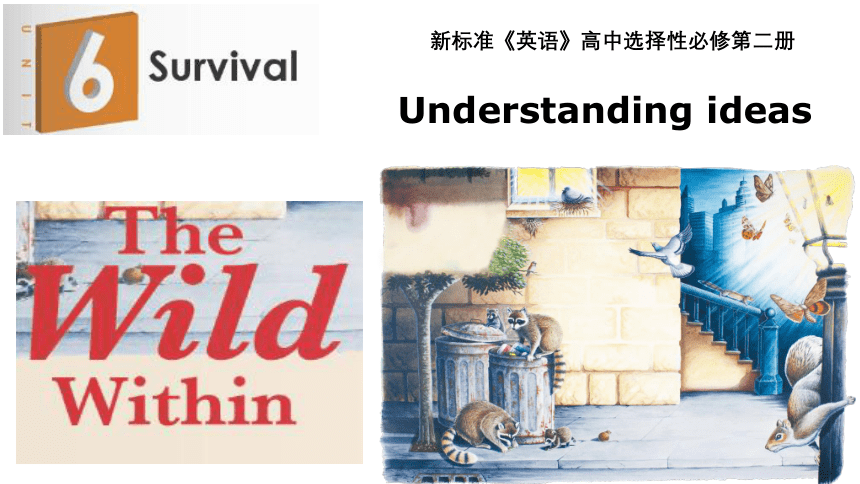 | |
| 格式 | pptx | ||
| 文件大小 | 5.4MB | ||
| 资源类型 | 教案 | ||
| 版本资源 | 外研版(2019) | ||
| 科目 | 英语 | ||
| 更新时间 | 2022-03-01 22:51:08 | ||
图片预览

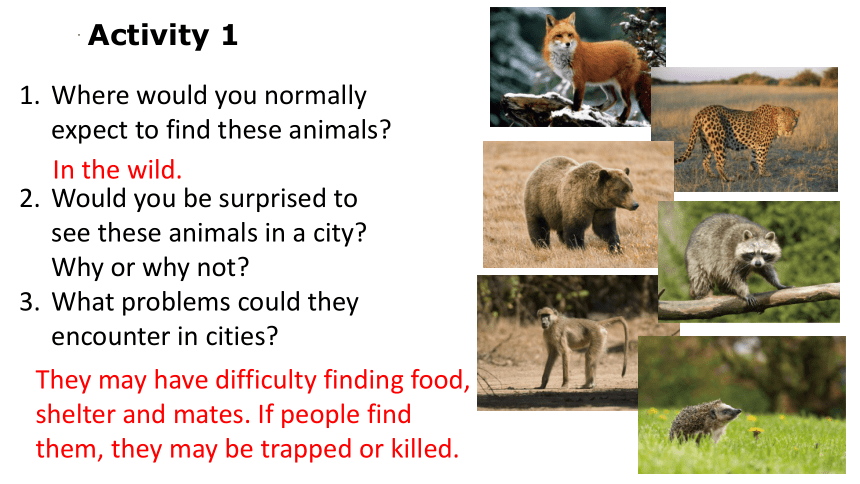

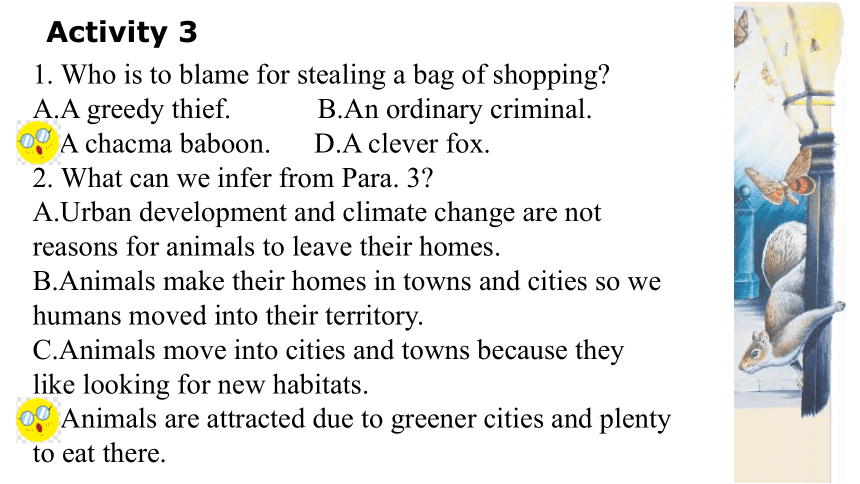
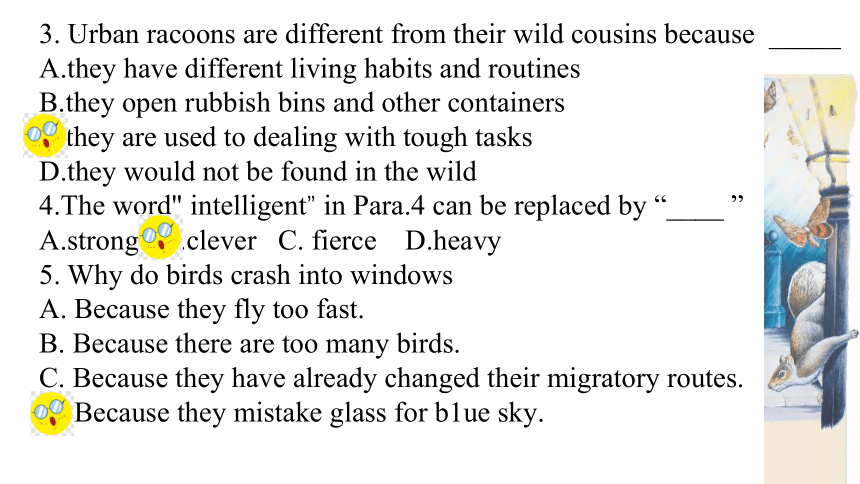
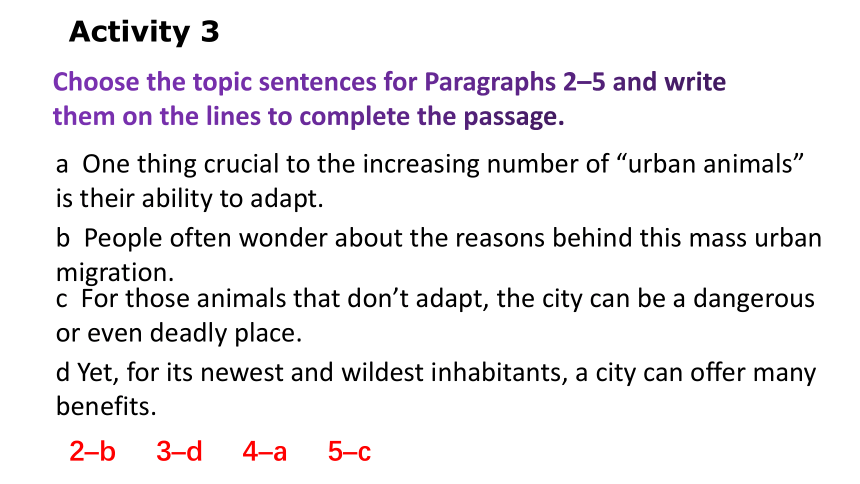
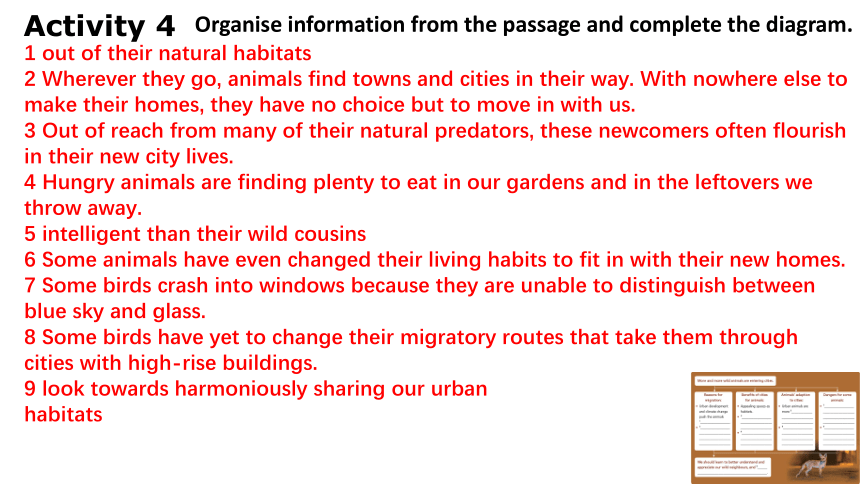
文档简介
(共15张PPT)
Understanding ideas
新标准《英语》高中选择性必修第二册
Activity 1
Where would you normally expect to find these animals
Would you be surprised to see these animals in a city Why or why not
What problems could they encounter in cities
In the wild.
They may have difficulty finding food, shelter and mates. If people find them, they may be trapped or killed.
Activity 2
Look at the title of the passage and the picture. Think about what the title means.
The title means the wild animals within the cities.
1. Who is to blame for stealing a bag of shopping
A.A greedy thief. B.An ordinary criminal.
C.A chacma baboon. D.A clever fox.
2. What can we infer from Para. 3
A.Urban development and climate change are not reasons for animals to leave their homes.
B.Animals make their homes in towns and cities so we humans moved into their territory.
C.Animals move into cities and towns because they like looking for new habitats.
D.Animals are attracted due to greener cities and plenty to eat there.
Activity 3
3. Urban racoons are different from their wild cousins because _____
A.they have different living habits and routines
B.they open rubbish bins and other containers
C.they are used to dealing with tough tasks
D.they would not be found in the wild
4.The word" intelligent” in Para.4 can be replaced by “____ ”
A.strong B.clever C. fierce D.heavy
5. Why do birds crash into windows
A. Because they fly too fast.
B. Because there are too many birds.
C. Because they have already changed their migratory routes.
D. Because they mistake glass for b1ue sky.
Activity 3
Choose the topic sentences for Paragraphs 2–5 and write them on the lines to complete the passage.
a One thing crucial to the increasing number of “urban animals” is their ability to adapt.
b People often wonder about the reasons behind this mass urban migration.
c For those animals that don’t adapt, the city can be a dangerous or even deadly place.
d Yet, for its newest and wildest inhabitants, a city can offer many benefits.
2–b 3–d 4–a 5–c
Activity 4
Organise information from the passage and complete the diagram.
1 out of their natural habitats
2 Wherever they go, animals find towns and cities in their way. With nowhere else to make their homes, they have no choice but to move in with us.
3 Out of reach from many of their natural predators, these newcomers often flourish in their new city lives.
4 Hungry animals are finding plenty to eat in our gardens and in the leftovers we throw away.
5 intelligent than their wild cousins
6 Some animals have even changed their living habits to fit in with their new homes.
7 Some birds crash into windows because they are unable to distinguish between blue sky and glass.
8 Some birds have yet to change their migratory routes that take them through cities with high-rise buildings.
9 look towards harmoniously sharing our urban
habitats
Think & Share
2. In the first paragraph, the author uses personification to describe what the urban animals are doing, with the aim of attracting readers’ attention.
城中的
野生动物
1 The crime took place in a seaside suburb of Cape Town. Spotting the car with its window left open, the greedy thief didn't hesitate. Within seconds, he had reached inside and run away with a bag of shopping. No matter how many crimes he committed, the police were powerless to arrest him. You see, this was no ordinary criminal: it was a chacma baboon. Once almost unheard of, scenes like this one in Cape Town are now common all over the world. With foxes in London, mountain lions in San Francisco and wild pigs in Hong Kong, it is almost as if our cities are being taken over by wild animals.
在开普敦的一个海滨郊区发生了一起犯罪活动。贪婪的窃贼在发现有辆车的车窗未关后,没有丝毫犹豫。几秒之间,他把手伸进车窗,抓出-袋东西逃之天天。不论他犯罪多少次,警方都无法抓捕到他。要知道,这可不是普通的罪犯:它是一只大狒狒。以前,在开普敦发生的这种事几乎闻所未闻,但现在这种事在世界各地都时有发生。伦敦出现了狐狸,旧金山出现了美洲狮,香港出现了野猪,我们的城市就像是被野生动物给占领了。
2 Most of us would assume that urban development and climate change are responsible for pushing the animals out of their natural habitats. However true this is, we also need to consider that some of these so-called "urban animals" have never moved at all - it's we humans who have moved into their trritory. Wherever they go, animals find towns and cities in their way. With nowhere else to make their homes, they have no choice but to move in with us.
人们总想知道这种大规模城市迁徙背后的原因。我们大多数人会认为,城市发展和气候变化是造成这些动物离开其自然栖息地的原因。无论事实如何,我们必须得明白,在这些所谓的“城市动物”中,有一些根本就没有迁徙过一-是我们人类搬到了它们的领地里。动物不论走到哪里,都发现有城镇拦路。既然没有别处可以安家,它们别无选择,只好搬来和我们一起住。
3 As our cities become greener, they offer increasingly appealing spaces to animals looking for new habitats. Out of reach from many of their natural predators, these newcomers often flourish in their new city lives. Today, foxes can be seen all over London - one even being found living on the 72nd floor of the Shard building when it was under construction! What's more, hungry animals are finding plenty to eat in our gardens and in the leftovers we throw away.
不过,城市可以给这些最新的也是最野生的居民以许多好处。随着我们的城市绿化越来越好,它们越来越吸引着寻找新栖息地的动物。由于远离自然界中的许多天敌,这些新来者往往在新城市生活中蓬勃发展。现在,伦敦随处都可以见到狐狸- -有一只甚至生活在当时在建的夏德大厦72楼!而且,饥饿的动物们从我们的花园里和我们扔掉的垃圾中找寻到大量的食物。
4 There is evidence that urban racoons are more intelligent than their wild cousins, as they frequently have to figure out difficult problems such as how to open rubbish bins and other containers which they would not find in the wild. Some animals have even changed their living habits to fit in with their new homes. Although naturally active at night, urban foxes come out in daylight if the reward is good enough. Their city location also means that they are getting a taste for the multicultural cuisine on offer from the garbage, such as hamburgers, lamb kebabs and even garlic bread!
对这些越来越多的“城市动物”来说,适应能力是关键。有证据显示,和野生的浣熊相比,城市里的浣熊更聪明,因为它们时常要想办法解决难题,比如怎么打开垃圾桶以及其他它们在野外不会见到的容器。为了适应新的家园,有些动物甚至改变了习性。尽管狐狸天生昼伏夜出,但如果回报足够丰厚,城市里的狐狸会在白天出来。城市的位置也意味着,它们可以吃到来自垃圾里的多元文化的菜肴,比如汉堡包、烤羊肉串甚至香蒜面包!
5 Unable to distinguish between blue sky and glass, birds crash into windows at speeds of about 50 kilometres per hour Recent studies estimate that between 400 million and 1 billion birds die from window impacts each year in the US alone. Shockingly, these deaths amount to around ten per cent of the total US bird population. Some species are more affected than others. One theory behind this is that these birds have yet to change their migratory routes that take them through cities with high-rise buildings.
对无法适应环境的动物来说,城市是个危险甚至致命的地方。无法分辨蓝天和玻璃的鸟类会以每小时50千米的速度撞向窗户。近期研究估计,仅在美国,每年就有4亿到10亿只鸟因撞向窗户而亡。令人震惊的是,这一死亡数量约占全美鸟类总量的10%。有些种类的鸟受此影响更大。一种理论认为,这些鸟类的迁徙路线让它们穿过这些有高楼大厦的城市,而它们还没有调整路线。
6 However they adapt to our ways of urban living, it's important that we get a better understanding of and even learn to appreciate our wild neighbours. Only then can we look towards harmoniously sharing our urban habitats. W hatever the reasons behind these species entering our cities, one thing is for sure as it's often a means of their survival, they could be with us to stay.
不论它们如何适应我们的城市生活,更好地理解甚至学会欣赏我们的野生邻居是非常重要的。只有那时,我们才能展望与它们和谐分享城市栖息地的未来。无论这些物种为什么进入我们的城市,有一件事是肯定的一一既然它们这么做通常是为了生存,那么它们就可以留下来和我们一起生活。
Understanding ideas
新标准《英语》高中选择性必修第二册
Activity 1
Where would you normally expect to find these animals
Would you be surprised to see these animals in a city Why or why not
What problems could they encounter in cities
In the wild.
They may have difficulty finding food, shelter and mates. If people find them, they may be trapped or killed.
Activity 2
Look at the title of the passage and the picture. Think about what the title means.
The title means the wild animals within the cities.
1. Who is to blame for stealing a bag of shopping
A.A greedy thief. B.An ordinary criminal.
C.A chacma baboon. D.A clever fox.
2. What can we infer from Para. 3
A.Urban development and climate change are not reasons for animals to leave their homes.
B.Animals make their homes in towns and cities so we humans moved into their territory.
C.Animals move into cities and towns because they like looking for new habitats.
D.Animals are attracted due to greener cities and plenty to eat there.
Activity 3
3. Urban racoons are different from their wild cousins because _____
A.they have different living habits and routines
B.they open rubbish bins and other containers
C.they are used to dealing with tough tasks
D.they would not be found in the wild
4.The word" intelligent” in Para.4 can be replaced by “____ ”
A.strong B.clever C. fierce D.heavy
5. Why do birds crash into windows
A. Because they fly too fast.
B. Because there are too many birds.
C. Because they have already changed their migratory routes.
D. Because they mistake glass for b1ue sky.
Activity 3
Choose the topic sentences for Paragraphs 2–5 and write them on the lines to complete the passage.
a One thing crucial to the increasing number of “urban animals” is their ability to adapt.
b People often wonder about the reasons behind this mass urban migration.
c For those animals that don’t adapt, the city can be a dangerous or even deadly place.
d Yet, for its newest and wildest inhabitants, a city can offer many benefits.
2–b 3–d 4–a 5–c
Activity 4
Organise information from the passage and complete the diagram.
1 out of their natural habitats
2 Wherever they go, animals find towns and cities in their way. With nowhere else to make their homes, they have no choice but to move in with us.
3 Out of reach from many of their natural predators, these newcomers often flourish in their new city lives.
4 Hungry animals are finding plenty to eat in our gardens and in the leftovers we throw away.
5 intelligent than their wild cousins
6 Some animals have even changed their living habits to fit in with their new homes.
7 Some birds crash into windows because they are unable to distinguish between blue sky and glass.
8 Some birds have yet to change their migratory routes that take them through cities with high-rise buildings.
9 look towards harmoniously sharing our urban
habitats
Think & Share
2. In the first paragraph, the author uses personification to describe what the urban animals are doing, with the aim of attracting readers’ attention.
城中的
野生动物
1 The crime took place in a seaside suburb of Cape Town. Spotting the car with its window left open, the greedy thief didn't hesitate. Within seconds, he had reached inside and run away with a bag of shopping. No matter how many crimes he committed, the police were powerless to arrest him. You see, this was no ordinary criminal: it was a chacma baboon. Once almost unheard of, scenes like this one in Cape Town are now common all over the world. With foxes in London, mountain lions in San Francisco and wild pigs in Hong Kong, it is almost as if our cities are being taken over by wild animals.
在开普敦的一个海滨郊区发生了一起犯罪活动。贪婪的窃贼在发现有辆车的车窗未关后,没有丝毫犹豫。几秒之间,他把手伸进车窗,抓出-袋东西逃之天天。不论他犯罪多少次,警方都无法抓捕到他。要知道,这可不是普通的罪犯:它是一只大狒狒。以前,在开普敦发生的这种事几乎闻所未闻,但现在这种事在世界各地都时有发生。伦敦出现了狐狸,旧金山出现了美洲狮,香港出现了野猪,我们的城市就像是被野生动物给占领了。
2 Most of us would assume that urban development and climate change are responsible for pushing the animals out of their natural habitats. However true this is, we also need to consider that some of these so-called "urban animals" have never moved at all - it's we humans who have moved into their trritory. Wherever they go, animals find towns and cities in their way. With nowhere else to make their homes, they have no choice but to move in with us.
人们总想知道这种大规模城市迁徙背后的原因。我们大多数人会认为,城市发展和气候变化是造成这些动物离开其自然栖息地的原因。无论事实如何,我们必须得明白,在这些所谓的“城市动物”中,有一些根本就没有迁徙过一-是我们人类搬到了它们的领地里。动物不论走到哪里,都发现有城镇拦路。既然没有别处可以安家,它们别无选择,只好搬来和我们一起住。
3 As our cities become greener, they offer increasingly appealing spaces to animals looking for new habitats. Out of reach from many of their natural predators, these newcomers often flourish in their new city lives. Today, foxes can be seen all over London - one even being found living on the 72nd floor of the Shard building when it was under construction! What's more, hungry animals are finding plenty to eat in our gardens and in the leftovers we throw away.
不过,城市可以给这些最新的也是最野生的居民以许多好处。随着我们的城市绿化越来越好,它们越来越吸引着寻找新栖息地的动物。由于远离自然界中的许多天敌,这些新来者往往在新城市生活中蓬勃发展。现在,伦敦随处都可以见到狐狸- -有一只甚至生活在当时在建的夏德大厦72楼!而且,饥饿的动物们从我们的花园里和我们扔掉的垃圾中找寻到大量的食物。
4 There is evidence that urban racoons are more intelligent than their wild cousins, as they frequently have to figure out difficult problems such as how to open rubbish bins and other containers which they would not find in the wild. Some animals have even changed their living habits to fit in with their new homes. Although naturally active at night, urban foxes come out in daylight if the reward is good enough. Their city location also means that they are getting a taste for the multicultural cuisine on offer from the garbage, such as hamburgers, lamb kebabs and even garlic bread!
对这些越来越多的“城市动物”来说,适应能力是关键。有证据显示,和野生的浣熊相比,城市里的浣熊更聪明,因为它们时常要想办法解决难题,比如怎么打开垃圾桶以及其他它们在野外不会见到的容器。为了适应新的家园,有些动物甚至改变了习性。尽管狐狸天生昼伏夜出,但如果回报足够丰厚,城市里的狐狸会在白天出来。城市的位置也意味着,它们可以吃到来自垃圾里的多元文化的菜肴,比如汉堡包、烤羊肉串甚至香蒜面包!
5 Unable to distinguish between blue sky and glass, birds crash into windows at speeds of about 50 kilometres per hour Recent studies estimate that between 400 million and 1 billion birds die from window impacts each year in the US alone. Shockingly, these deaths amount to around ten per cent of the total US bird population. Some species are more affected than others. One theory behind this is that these birds have yet to change their migratory routes that take them through cities with high-rise buildings.
对无法适应环境的动物来说,城市是个危险甚至致命的地方。无法分辨蓝天和玻璃的鸟类会以每小时50千米的速度撞向窗户。近期研究估计,仅在美国,每年就有4亿到10亿只鸟因撞向窗户而亡。令人震惊的是,这一死亡数量约占全美鸟类总量的10%。有些种类的鸟受此影响更大。一种理论认为,这些鸟类的迁徙路线让它们穿过这些有高楼大厦的城市,而它们还没有调整路线。
6 However they adapt to our ways of urban living, it's important that we get a better understanding of and even learn to appreciate our wild neighbours. Only then can we look towards harmoniously sharing our urban habitats. W hatever the reasons behind these species entering our cities, one thing is for sure as it's often a means of their survival, they could be with us to stay.
不论它们如何适应我们的城市生活,更好地理解甚至学会欣赏我们的野生邻居是非常重要的。只有那时,我们才能展望与它们和谐分享城市栖息地的未来。无论这些物种为什么进入我们的城市,有一件事是肯定的一一既然它们这么做通常是为了生存,那么它们就可以留下来和我们一起生活。
